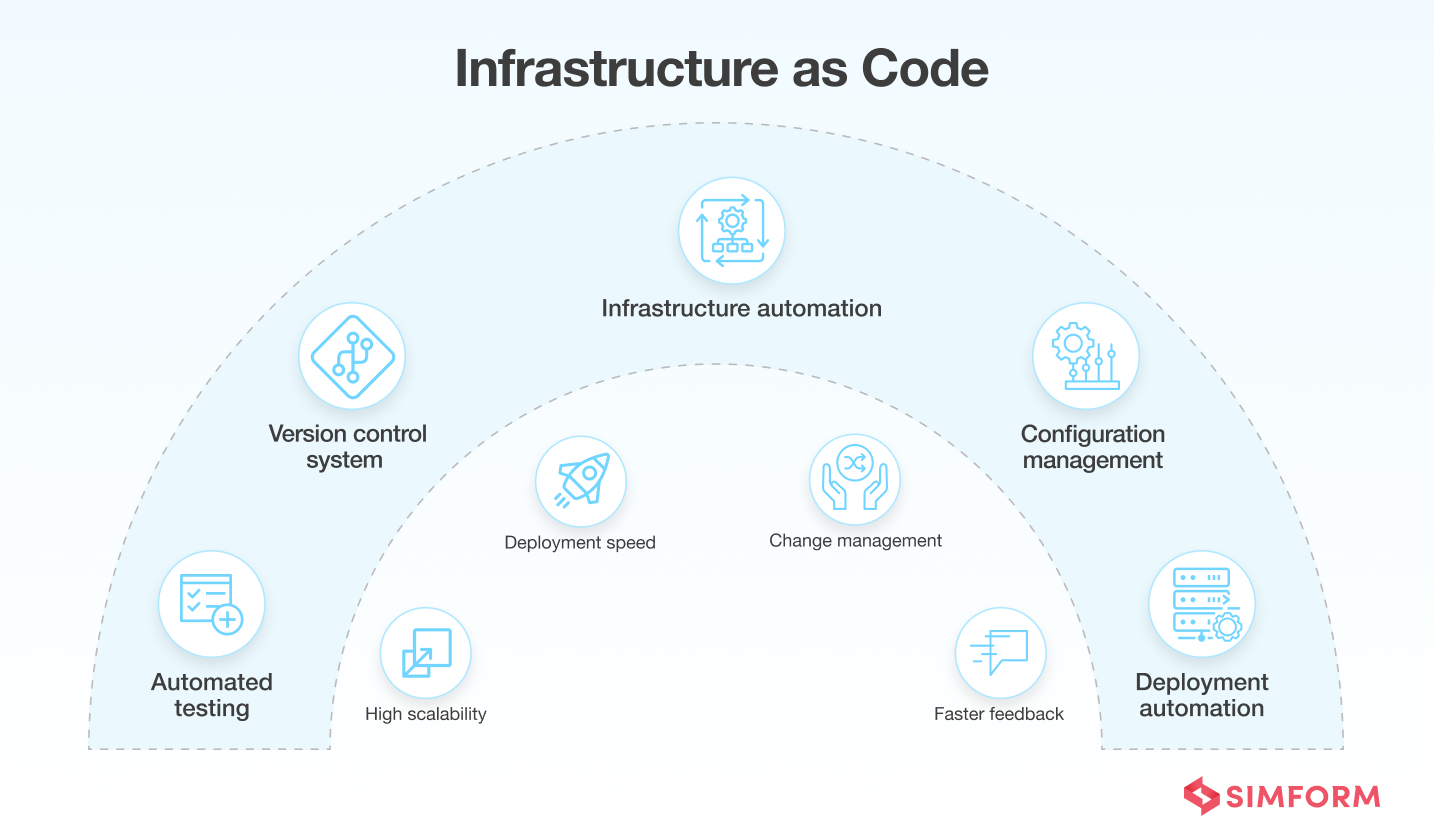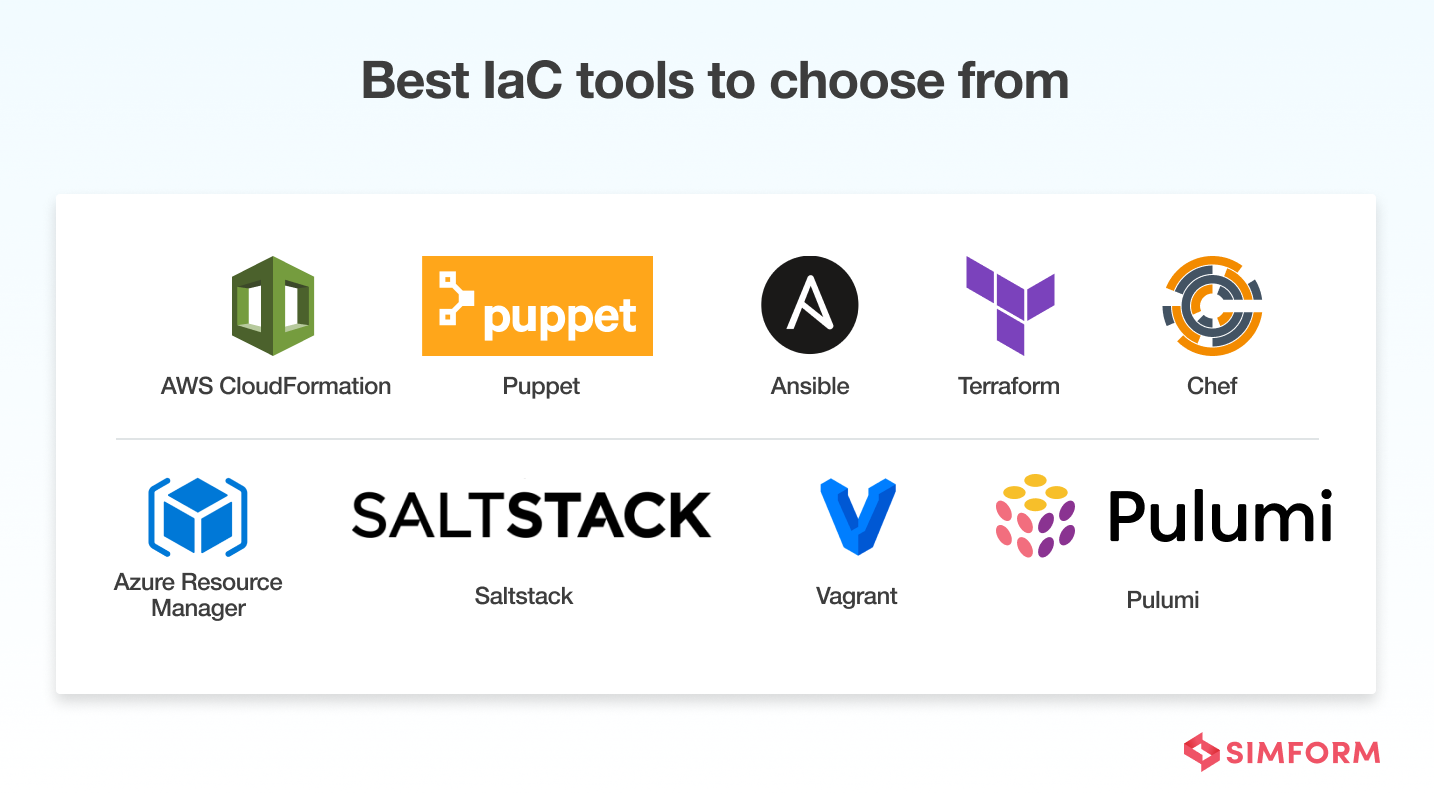“If you can deploy Infrastructure as Code, you’ve drastically minimized both the risk of human error and security risks.” – Marc Fischer, Dogtown Media LLC.
We couldn’t agree more!
A few years ago, servers were the irreplaceable menace that gave developers nightmares. Even if one server experienced downtime, the entire system collapsed and finding out the issue required piecing together every misstep and miscalculation. Let’s not even talk about the business lost during this whole time.
Fast forward to the present day:
IaC is the messiah that the development world was waiting for all along. An infrastructure that is flexible enough to offer rapid and secure responses and also absorb the ever-changing user demands without compromising on the performance.
This article explores what DevOps Infrastructure as Code is, how it benefits organizations, how to leverage it, and which tools to use for its effective implementation.
What is DevOps Infrastructure as Code?

The primary principle of Infrastructure as Code (IaC) is automating the provisioning and management of infrastructure through code, replacing the manual processes. It requires you to generate configuration files that store your infrastructure specifications. Doing so allows you to edit and distribute configurations more easily and ensure that your development team provisions the same environment every time. IaC helps enforce configuration management and prevents any undocumented or ad-hoc changes in your configurations.
Another major benefit of IaC implementation is dividing your infrastructure into modular components and connecting them through automation. It eliminates the need to manually provision/manage servers, all the operating systems, and storage every time you need to either develop or deploy an application.
Once you decide to implement IaC into your ecosystem, there are two approaches you can choose from: declarative and imperative.
Difference between declarative and imperative IaC
-
Declarative approach
By adopting this approach, you can define the required state of your system and include the resources and characteristics it should possess. An IaC tool takes care of how to implement it and achieve the desired results on its own. IaC tools like Terraform, AWS CloudFormation, Ansible, and Puppet are preferred among the developer community.
-
Imperative approach
This approach requires you to list the steps the IaC tool should follow while providing a resource. These series of command imperatives instruct the tool to build each environment. A popular example of an imperative IaC tool is Chef. Although IaC tools are generally compatible with both approaches, they prefer a particular approach over the other.
Now, we know what IaC is and how to implement it. But, the real deal is understanding how it can benefit your business and improve your ROI.
What are the Key Benefits of Using IaC in DevOps?
1. Seamless automation
Data center management has always been largely dependent on manual management and is prone to human error. IaC is the game-changer that minimizes manual intervention with the help of automation.
Just as DevOps promotes a collaborative approach to development, eliminating the bulky monoliths, IaC automates the complex, time-consuming provisioning processes that modern applications are built for.
IaC standardizes the processes and uses logs for creating detailed documentation to allow new team members to work on the infrastructure and its management without any challenges.
2. Cost optimization
Since the IaC model represents all the resources in code, it lets you see what is working and what isn’t and accordingly change the plans.
Moreover, automation enables your developers to concentrate on priority tasks rather than manual grunt work, which helps control payroll costs and scale your employees’ salaries to fit their workloads.
3. Consistent configuration and setup
Infrastructure deployment is the final stage of the cloud migration process, involving configuration and setup. Both these processes require standardization to eliminate human error, accelerate development, and reduce resource wastage.
If done manually, you can expect at least one instance of error, responsible for building inconsistencies and differences in the configuration. Also, executing these processes rapidly is important to avoid sudden setbacks and unwanted downtime.
IaC is key in standardizing the setup process, decreasing the possibility of human errors and incompatibility issues, and improving overall application performance.
4. Improved development speed
IaC enables deploying cloud architectures in multiple stages to bring efficiency to the software development lifecycle. While developers can create their own sandbox environments for development, QAs can access a production copy for testing.
Moreover, performing user acceptance testing and security testing in the same environment and deploying infrastructure in a single step is possible.
IaC also allows you to adopt Continuous Integration and Deployment to accelerate your development processes. It can shut down resources when not in use, allowing your teams to maintain an organized cloud environment.
5. Enhanced security
One of the significant IaC features includes one-way deployment. IaC enables the provisioning of computing, networking services, and storage with code and their deployments in the same way to a private or public cloud.
Plus, security standards can also be created and deployed similarly, eliminating the need for an approver for every security change, especially for infrastructures that need high-security standards.
6. Self-documenting
Like any other code, IaC can be self-documenting, meaning that it is written in a clear and descriptive way that explains its purpose and functionality.
Self-documenting code can make it easier to add new team members, as they can easily understand the IT infrastructure and how to modify it. Also, self-documenting code saves time for new developers, as they do not need other tools or documentation.
7. Disaster recovery
Infrastructure as Code (IaC) streamlines disaster recovery by quickly recreating and recovering infrastructure after system failures or disasters. An organized infrastructure code enables swift restoration to the previous state.
During disasters or system failures, the stored infrastructure code acts as a blueprint to recreate your environment. It provides instructions for rebuilding servers, networks, and configurations. This enables efficient system restoration, minimizes downtime, and decreases operational disruptions.
In addition, IaC eliminates the need for manual reconfiguration, reduces errors, and ensures a consistently restored environment. This reproducibility feature enables quick recovery and confident resumption of normal operations.
Now that It is an established fact that IaC comes with many advantages to businesses, it’s not free of challenges. Although the nature of challenges may differ according to the industry, here are a couple of common ones you can expect.
Potential IaC challenges and their solutions
Steep learning curve
Implementing IaC demands changes in the process. Your team members must learn to code in the preferred language in which the IaC will be written, gain expertise in developing pipelines for code execution, or adopt new conventions or standards.
Moreover, if your team lacks adequate knowledge of IaC tooling and its updates and improvements, you may end up with an incompatible toolset that slows down your implementation progress.
Solution:
You will need to prepare your team, hire new members experienced in IaC implementation, or conduct training sessions for your existing ones.
They will require a deep understanding of IaC scripts in HCL, Python, or Ruby and know how the declarative approach works to simplify the process.
Alternatively, you can choose to outsource IaC services during the initial phase of adoption to give your team the time they need to acquire these skills.
Configuration drift
A common challenge in IaC –configuration drift– arises when gaps between IaC configuration and the infrastructure arise, especially during the initial stages of the IaC journey.
It usually occurs because the software development team is unaware of the key changes essential for infrastructure provisioning, and they prefer to make those changes manually in the console.
As a result, it creates a drift as what the code defines does not match what is deployed and results in an outage when the code reverts to the manual changes.
Solution:
Inform your team about the outcomes of making manual changes in the console and instruct them to avoid it under any circumstances. Also, you can ensure there is no interference after setting up the IaC workflow.
If there is any modification in the infrastructure, it must be done as per the pre-decided maintenance workflow. In a survey by Synk, 48% of the respondents said they rarely resort to tweaking the infrastructure directly and prefer to fix the code first as a best practice. However, if you must make new changes to the system different from the rest, they will have to reflect in the code configuration.
Human error
One of the primary challenges faced when utilizing Infrastructure as Code (IaC) in DevOps is the inherent risk of human error. Despite the automation of IaC architecture and machine development processes, certain manual steps still need to be performed.
And one such step is generating the parent code, which poses a risk of manual errors caused by humans. Even a single mistake in a configuration file can lead to serious problems like security breaches and data issues.
Solution:
Make it a regular and consistent practice to conduct quality assurance inspections. This ensures thorough verification of the code that builds your IT infrastructure.
Unauthorized access
Imagine you’re using IaC on the cloud, and one worry that might cross your mind is the possibility of the cloud server managers getting hold of your private and sensitive data.
It’s a valid concern because you want your information to be confidential. And there are high chances that your cloud managers may misuse your information for their personal benefit.
Solution:
Follow strict security standards such as ISO 27017:2015, ISO 9001:2008, and Multi-Tier Cloud Security Standard Level-3 to protect your data and maintain a secure environment.
Also, implement other security best practices such as encrypting your data, managing your secrets, applying the principle of least privilege, testing and reviewing your code, and using secure and reliable tools and platforms.
Multi-environment complexity
Cloud providers have unique methods of using IaC. They have systems, tools, and rules for managing and deploying infrastructure. Since there is no universal IaC standard, the security settings that work for one provider may not work for another.
Using multiple cloud providers, you must create different security strategies for each. Each environment requires a customized approach to meet specific requirements and apply security measures. This means that a separate security strategy might be required for each environment.
Solution:
When it comes to tackling multi-cloud complexity, there are three approaches you can take.
Firstly, let your DevOps team select the best components or services from different cloud providers. Let them cherry-pick what works best for your needs.
Second, prioritize your applications, services, and data in your overall strategy. And lastly, don’t forget to set up the ability to easily scale and support the fast-paced evolution of delivering services across various clouds.
Popular use cases of Infrastructure as Code
So you have decided to adopt IaC in your ecosystem, but how to make the most of it? Here are 3 use cases to get you started on the implementation journey:-
Cloud deployments
Primary uses of IaC are resource automation, application configuration, and cloud deployments. It is compatible with public clouds like AWS, Azure, or private environments, including Windows Server or vSphere. For effective management and deployment of cloud resources and configurations, you can leverage template files, normally written in JSON. It can be especially useful if your organization uses a hybrid-cloud environment, and you can manage different cloud environments with a single configuration.
Monitoring
The IaC monitoring covers a different aspect of data than application monitoring. While app monitoring focuses on business-centric goals, IaC is more concerned with reports, alerts, and logs related to the infrastructure. Organizations that manage multiple platforms for their business needs can access error reports and activity logs produced by an IaC tool and the cloud service to get detailed insights about the infrastructure.
Infrastructure testing
IaC helps organizations create a test environment that is fully functional and identical to their production environment. As a result, your teams have the liberty to test and experiment with multiple updates, changes, or features. Moreover, for an organization that has newly adopted IaC, writing IaC can be tricky and demands extensive trial and error. However, the testing environment provides an advantage for improving the infrastructure and widens the scope of IaC capabilities without affecting the services.
Jordan McQuown, CTO at George Jon, shares his insights on maintaining quality control and security, “It’s easy to accidentally introduce security holes that traditional infrastructure deployment plans already account for. The benefits of an IaC approach are many. But ensuring you have a complete program, with quality control and security locked in, will be more critical than ever.”
What are the Best Practices for IaC Implementation effectively?
Implementing a proper set of best practices can improve your team’s productivity and bring considerable cost savings. As IaC constantly evolves, it is important to have a foundation of processes that will keep a tab on implementation.
Make the code your focal point
Since code is the heart of IaC, you must configure your necessary infrastructure as code in configuration files as extensively as possible. Such files act as the single source of truth for all your specific infrastructure demands. Once you have all the code at your disposal, you can quickly and seamlessly deploy your infrastructure without logging into the server to make any changes manually. Also, you can skip the documentation part about the state of the infrastructure, as your code is sufficient to fulfill that requirement.
Prioritize Continuous Integration/Continuous Delivery
Similar to your application source code, the infrastructure code must be managed through Continuous Integration/Continuous Delivery. In addition, it is important to set up automated tests that run every time the code undergoes a configuration change. When applied to the infrastructure configurations, continuous testing can prevent many potential post-deployment issues. Additionally, continuous monitoring helps identify threats constantly and monitor the infrastructure’s security throughout the development lifecycle.
Sean Barker, CEO at cloudEQ explains why CI/CD is crucial, “A complete continuous integration/continuous deployment pipeline that includes IaC for applications that change quickly will drastically improve your speed to market and reduce costs.”
Go for a modular architecture
When choosing an IaC solution, you must prioritize using an immutable infrastructure. To achieve this, you need to leverage a defined infrastructure several times and then replace it when there is a need for configuration change or update. This step eliminates the need to change the entire infrastructure configuration, which avoids configuration drifts, brings consistency, and enhances security. With minimal or no configuration changes, developers can track every edit and implement a more balanced process.
What are the Top Tools to Implement Infrastructure as Code
in DevOps?

AWS CloudFormation
With the help of CloudFormation, you can easily and quickly provision and manage different AWS and third-party resources with IaC.
Key features include:-
- Scales your resources and automates resource management by integrating with different AWS resources.
- Leverages open-source CLi to build resource providers for provisioning and managing third-party application resources.
- Codes your infrastructure from scratch using a preferred template language, while CloudFormation provisions and manages the tech stack and resources described in the template.
Puppet
It’s an open-source configuration management tool. Puppet’s main function is to manage multiple application servers simultaneously.
Key features include:-
- Ruby-based Domain Specific Language (DSL) allows you to describe your infrastructure’s necessary end state.
- Reduction in downtime due to misconfiguration and effective disaster recovery.
- Supports Mac OS, Microsoft Windows, Debian, and more with easy-to-learn language for defining configurations.
Ansible
Red Hat introduced Ansible intending to promote simplicity in automation. From provision and configuration to application management, it enables automating all the processes with ease.
Key features include:-
- Creates multiple identical environments with all the security baselines while Ansible takes care of the compliance requirements.
- Executes playbooks to create and manage the necessary infrastructure resources.
- Code written in YAML enables understanding and deploying the configurations easily. Also, you can expand its features to write your own Ansible modules and plugins.
Terraform
A popular and open-source tool for infrastructure automation, Terraform is used for provisioning, configuring, and managing the infrastructure code.
Key features include:-
- Utilizes the same CLi workflow to plan and build IaC across different infrastructure providers.
- Provision of multiple environments with the same configuration to manage the complete lifecycle of your infrastructure. It significantly reduces human errors and promotes maximum automation.
- Pre-execution check allows configuration validation to ensure that the configuration meets the expected results before updating/provisioning the infrastructure.
Chef
A developer’s favorite, Chef focuses on deploying and modeling a scalable and secure automation process across any environment.
Key features include:-
- Uses procedural style language, so users can write the code and describe step-by-step how to achieve the required state. Also, the user can choose the optimal deployment process.
- Uses Ruby-based DSL to create recipes and cookbooks to specify the definite steps for achieving the application configuration.
- Enables DevOps teams to provision and deploy on-demand infrastructure easily.
Why choose Simform for IaC implementation?
At Simform, we provide different DevOps consulting services to organizations, including release management, automation, infrastructure management, and infrastructure as code.
Recently, we helped one of our clients who desired an advanced marketing automation platform tailored specifically for auto dealerships.
To fulfill their needs, we opted for Mautic as a foundation for building this custom platform. Our team integrated DMS and CRM systems via REST APIs, syncing customer, service, and lease plan data to eliminate redundancy.
Read our detailed case study to know how we helped our client and discover how we can assist you.
